There was a time, not long ago, when I would have considered the battle for the world’s best laptop daypack to be one of such insurmountable difficulty that debating such idealism would be a mere exercise in futility. So many different choices exist that it would seem reasonable to conclude that 100% of all specific needs can be met, by some backpack, somewhere, and it is merely a matter of digging through the 95% of unsuitable options before settling on The One, with no objective champion to reign victoriously over what is clearly a subjective set of requirements.
Or you could simply conclude the opposite, which is to declare the problem insolvable and claim nothing will ever work out perfectly and there’s no reason to bother trying, and you can just get something decent and call it a day, and remain mildly dissatisfied for the remainder of your existence. As a pessimistic perfectionist, I was firmly within this camp.
So it was something of a surprise to run into a backpack that, despite swimming in a sea of a zillion competitors, manages several things I’ve simply never seen before. It’s the Tom Bihn Synapse, and I’ve been salivating over it had my eye on it for quite some time.
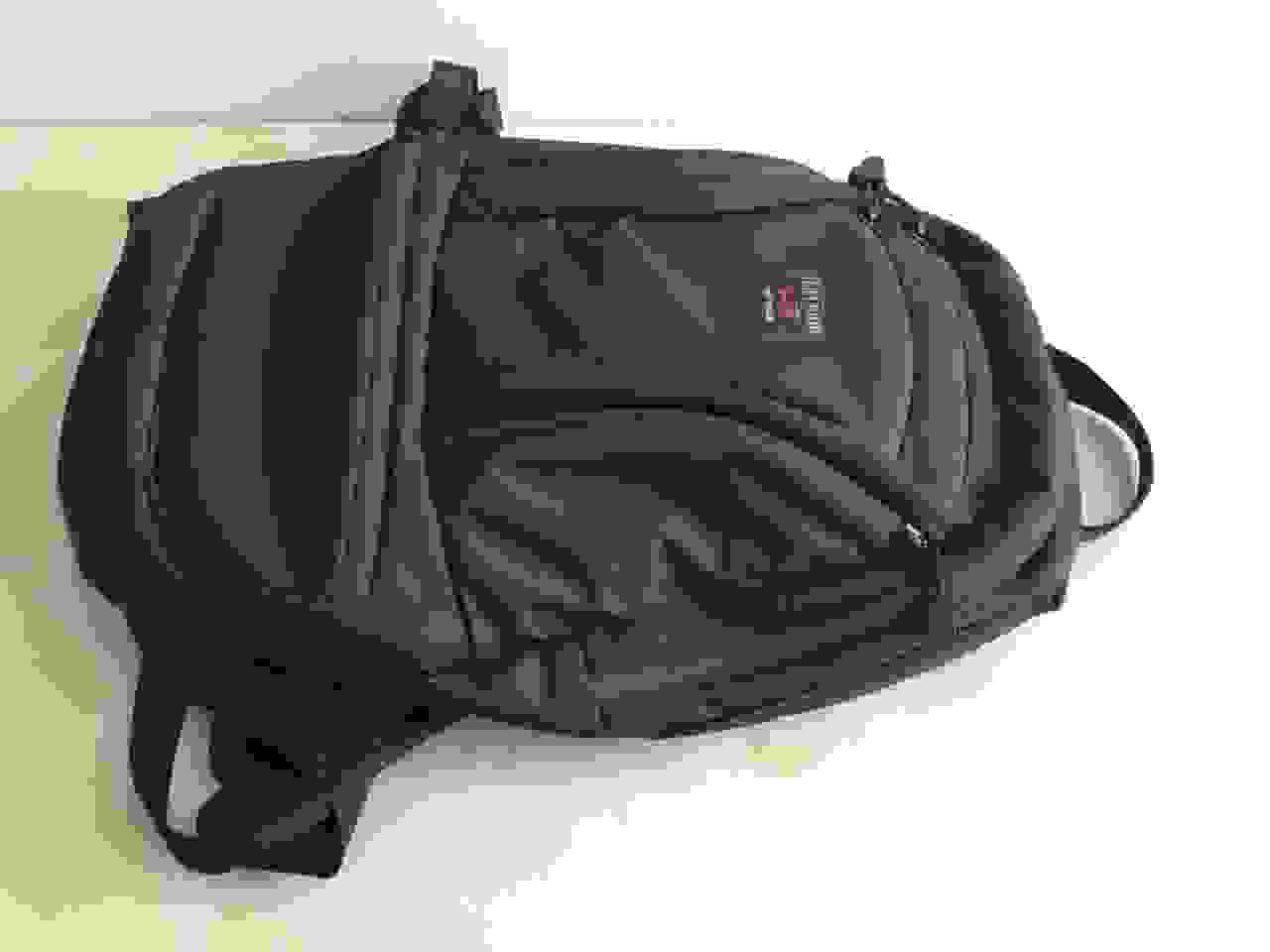
Tom Bihn recently invited me on a tour of their Seattle factory, where they handle every stage of design and production (except when field testing, of course), so whenever they have an idea, they can walk out of the office and right onto the factory floor and do it, instead of emailing a factory on the other side of the planet and hoping it all works out.
They’ve built a reputation for super-tough materials, flawless construction, direct-to-customer relationships (you can’t get their gear anywhere else), great customer service, and clever design details, all of which have resulted in a rabidly loyal fan base, many of whom end up collecting the whole set.
They recently offered me a Synapse 25 to review, along with a gift bag full of packing accessories, and for a pack described as “the last you’ll ever buy,” I was excited to try it out.
The Tom Bihn Synapse 25
Let’s start with the basic details. It’s a 25 liter, very “regular” sort of pack, the kind you’d take to work or school, or just randomly carry wherever, from city wandering to day hikes and so on, with included (but removable) sternum and waist straps to accommodate light or heavy loads.
Specs:
- Capacity: 25 liters
- Height: 20″ (51 cm)
- Width: 13.4″ (34 cm)
- Depth: 9″ (23 cm)
- Weight: Approx. 1 lb 13 oz (820 g), depending on fabric options
- Price: $195 (+$35 for removable laptop sleeve)
(There’s also a 19 liter version that works much the same way, but this review is specifically for the larger one.)
A few things worth mentioning here:
- It’s almost a full pound lighter than certain similarly-sized laptop backpacks, for a variety of reasons that I did not find problematic.
- Its dimensions are just a bit smaller than maximum carry-on requirements for most airlines, meaning it would be a great carry-on bag.
- Speaking of size, it’s far more spacious than you’d expect, because Tom Bihn bags are measured according to ASTM International standards, which involves filling the pack with plastic spheres until it’s full, then emptying them into a measuring chamber (a process which I got to see while visiting the factory), whereas other manufacturers often use different methods, which can produce wildly inflated numbers. I really enjoyed
taking a look at Tom’s ballslearning about these behind-the-scenes aspects of design, which is why Tom Bihn’s 25 liters might be more like someone else’s 30, or even 35 (for reference, I was able to fit everything on this list in there, though just barely).
Layout and organization
This pack is for the organizationally obsessive. Observe:
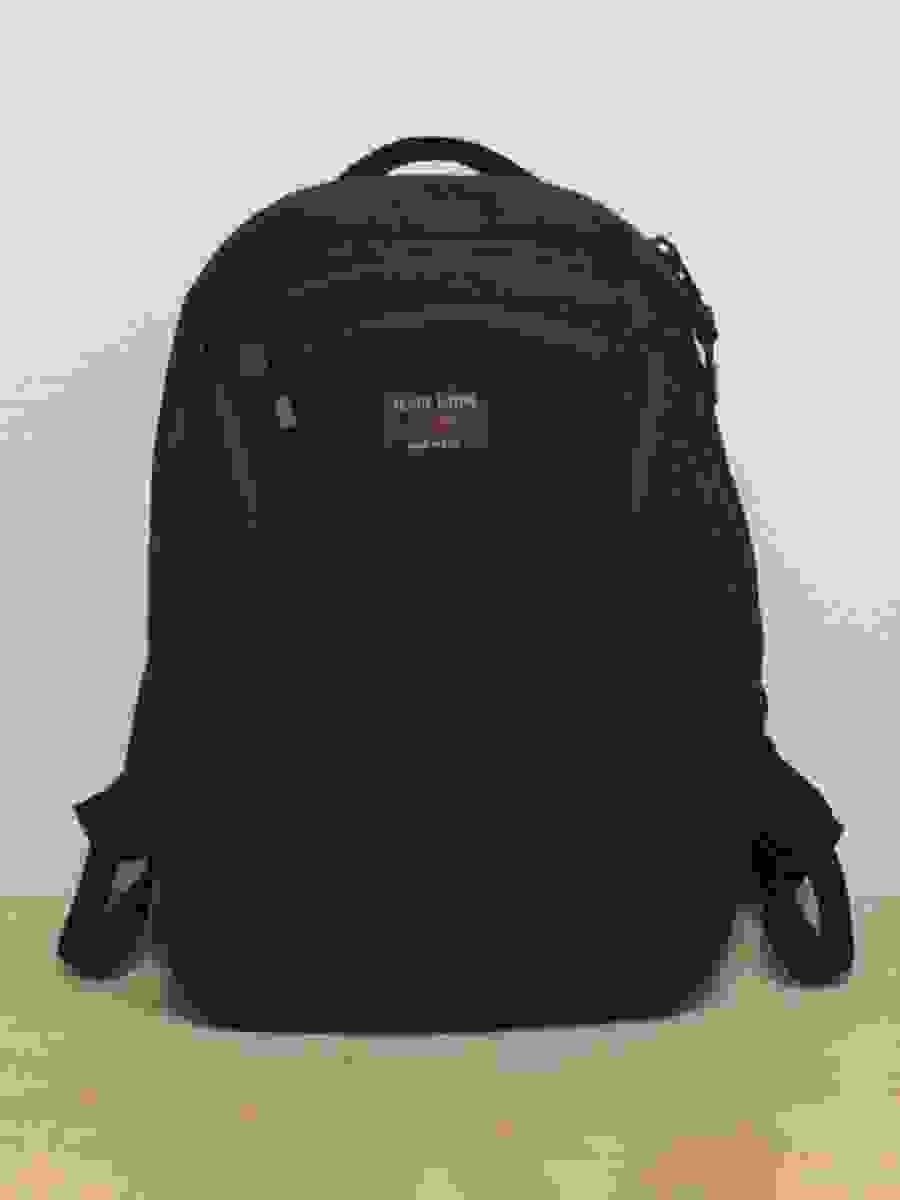
As you can see, it offers a whole lot more compartmentalization than others, with five spacious pockets in addition to the full-height main chamber, yet with an understated simplicity that doesn’t announce itself as anything more than a typical backpack.
But what’s also apparent is what it does not have: No dangly external compression straps, and no snaggy mesh side water bottle pockets.
Ordinarily I’d consider the lack of side water bottle pockets to be an instant deal-breaker (I’ve complained before about poorly-designed side pockets that are incapable of holding anything larger than a pencil) but in this case, it’s actually the Synapse’s best feature.
The defining characteristic of the Synapse:
The water bottle pocket hasn’t been removed, but rather relocated, to the center of the pack, where it can never be off balance:
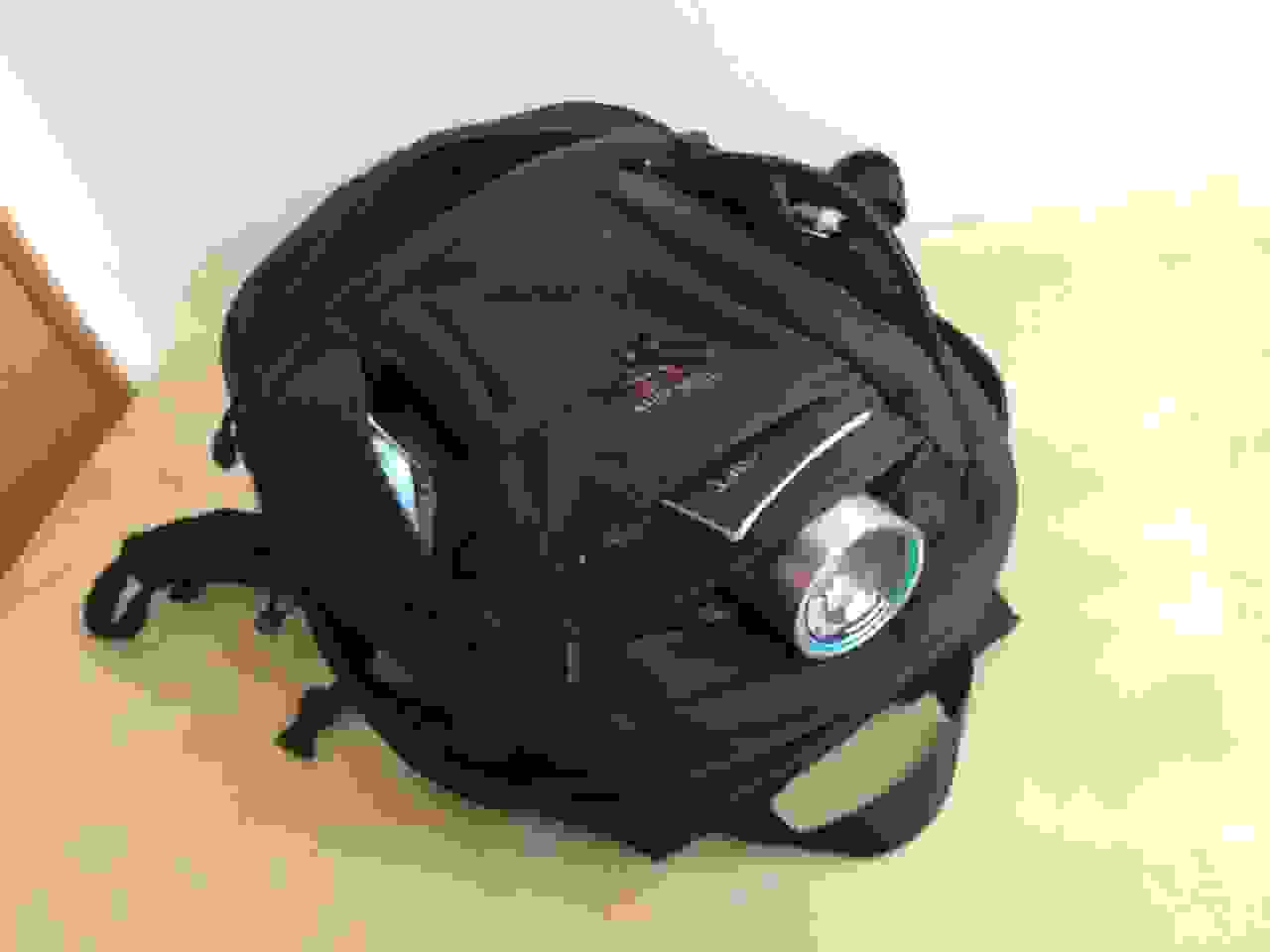
As you can imagine, placing the heaviest item in the center of the pack makes a huge difference in comfort, keeping the weight properly balanced instead of dragging you sideways into lopsided awkwardness, or forcing you to place heavy items on the opposite side just to balance the load, before removing them after you drink the water from the opposite side. Plus it zips shut, so the bottle can never fall out. I don’t know why no one seems to have thought of this before, and I can’t see myself going back to the normal way anytime soon.
By the way, that water bottle is a $70 Grayl, which is not only a water bottle, but also a filtration device. As you can imagine, it’s not something I want falling out of a woefully insufficient side pocket and rolling under a bus while I walk away, which is why I was so interested in the Synapse in the first place. Since a filtered water bottle is both heavier and more valuable than a disposable plastic water bottle, centering it in a securely zippered pocket is the perfect solution.
Never again shall I gaze incredulously at the stupidly tiny and ever so fragile side “water bottle” pockets that couldn’t possibly hold the water bottles that are sold in the same stores as the pack if their designers’ lives depended on it. Never again I say!
Okay, rant over. For now, anyway.
Remaining exterior pockets:
The central placement of the water bottle pocket determines the layout of the remaining pockets, which surround it on all sides:
- The side pockets are each big enough to hold a light rain jacket, or maybe even an ultralight down jacket (though a vest would be more manageable). The left has a few pen or pencil slots, while the right has a microfiber-lined smartphone slot. Both are designed to expand or contract depending on the size of the water bottle placed in the central compartment (it can handle 1 liter bottles), so a skinny water bottle will allow you to carry more in the side pockets.
- The outermost pocket is conveniently passport-sized.
- The bottom pocket is actually huge. I managed to get a pair of size 10 shoes in there (barely), though I think it would make more sense to store smaller or more flexible items in there, like a sweater.
As with all Tom Bihn compartments, each of these have internal attachment points for clipping all sorts of accessories to the bag, including any of their myriad organizational pouches, which include everything from drawstring stuff sacks to zippered organizers of all shapes and sizes:
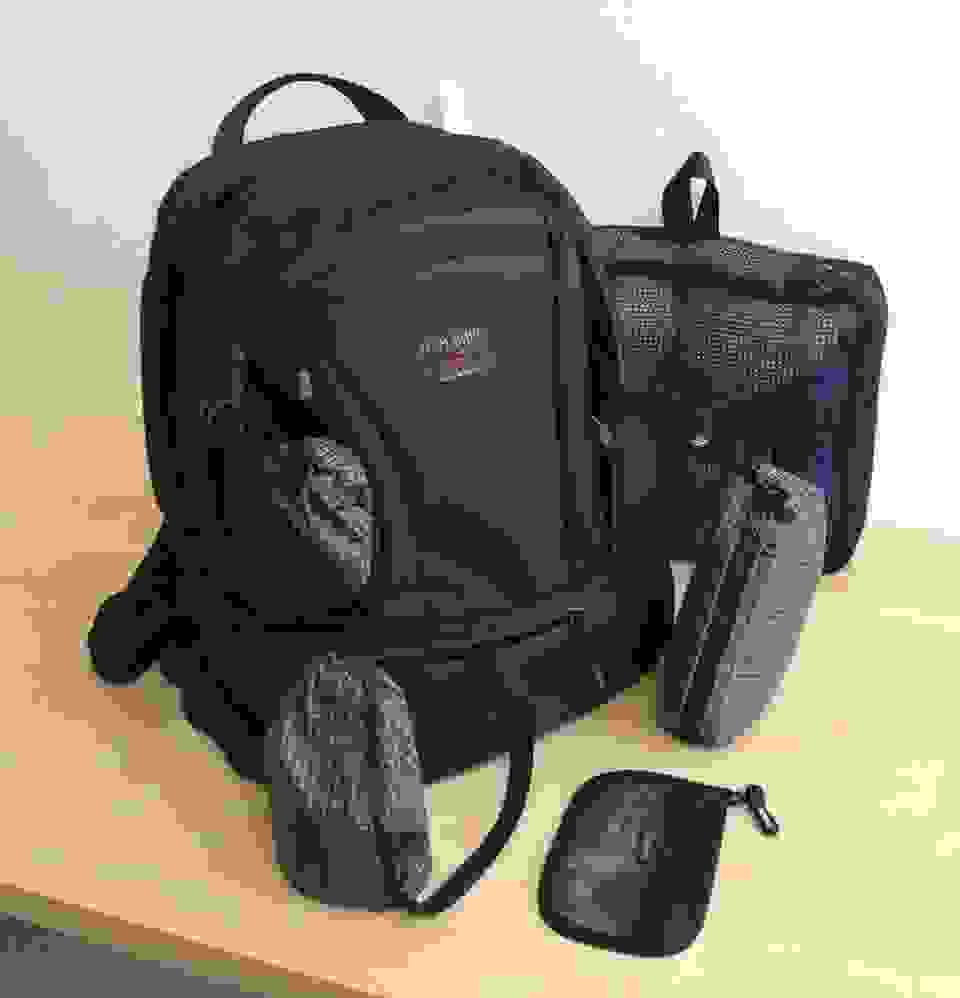
This way you won’t accidentally donate a few of your belongings to whomever takes over your room after you leave. Like I did in Peru that one time. Shush.
The main chamber
This spans the full height and width of the pack, and thus can store quite a bit, and allows even more organization because of its divider panel, which is quite spacious (though if you’re not using it, you’ll occasionally have to shove it out of the way like an overly-friendly shower curtain).
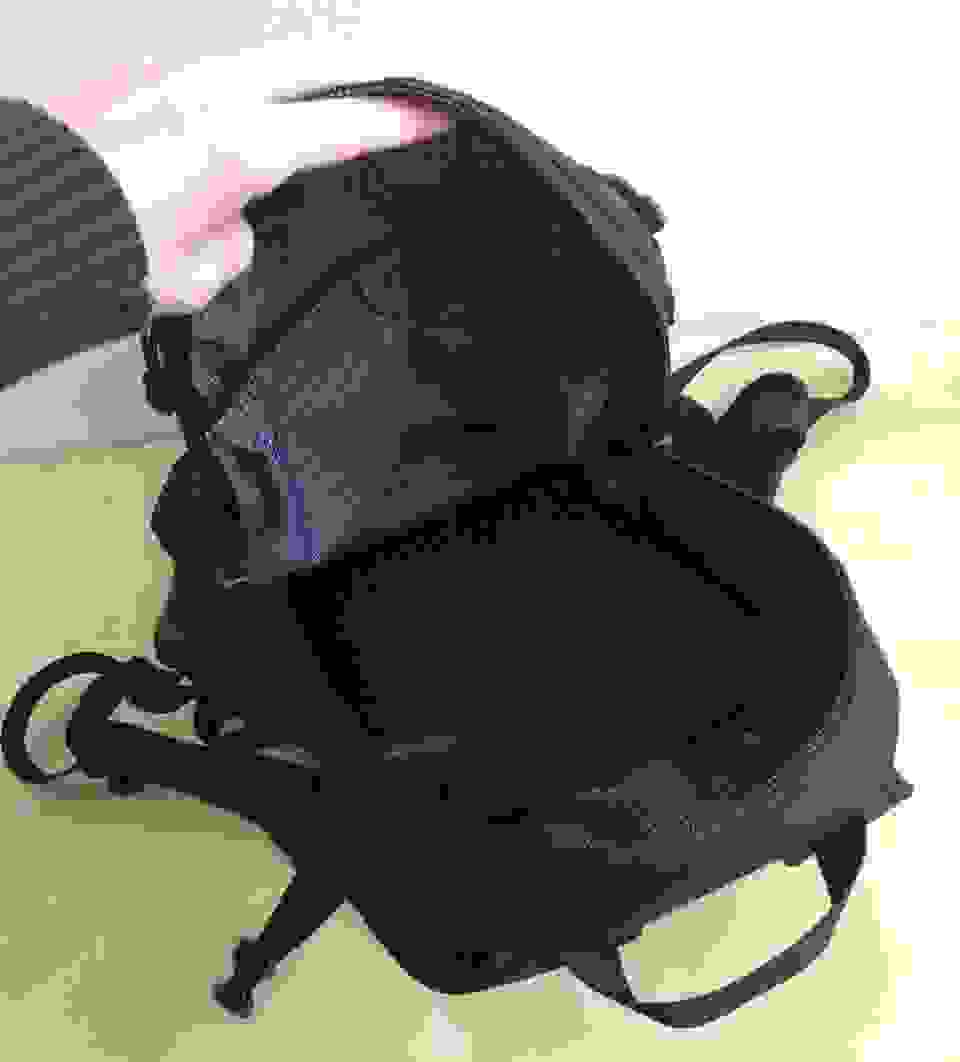
Since the main compartment only occupies the space directly beneath the zipper, you only ever pack straight down, rather than diagonally. Many packs of this size often feature a single zipper to service the entire pack, making it more difficult to pack it to capacity, which is less of a problem here. It’s also sectioned off from the other compartments, meaning you can still make use of them, even when the main compartment is full (though of course overstuffing it will eventually intrude on their space).
And here we are at the other distinguishing feature…
The checkpoint friendly laptop sleeve
The laptop sleeve is hiding a few tricks, like how it can do this:
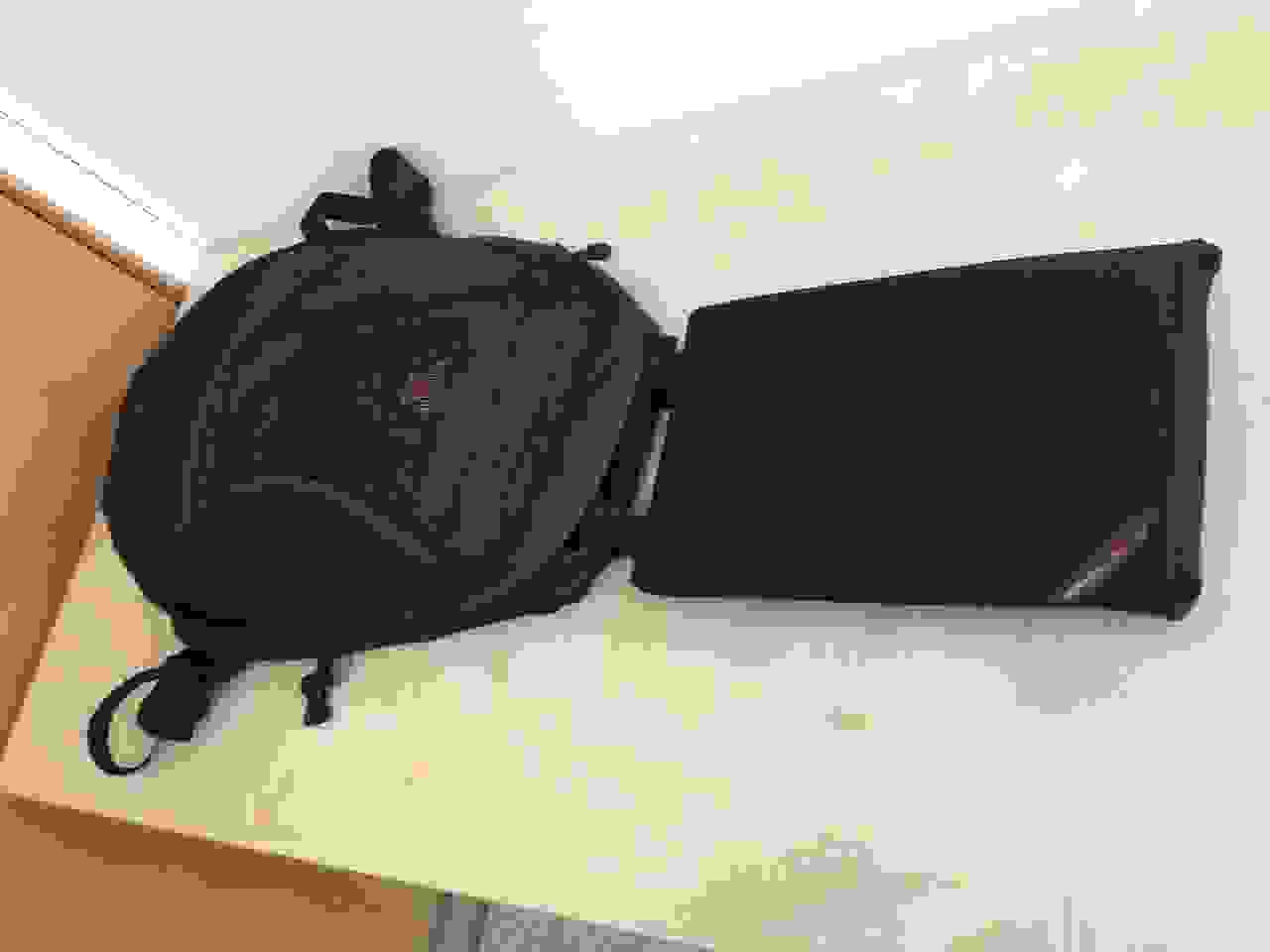
You know how you need to remove your laptop when going through airport security? Well, you’re allowed to leave your laptop in a padded sleeve, and set it on the conveyor belt to be scanned.
So Tom Bihn devised what they call the Cache with Rails system, which allows you to remove the laptop sleeve without detaching it from the bag, and then you just slide it back in after the scan. This is quite convenient for frequent air travelers, who need all the convenience they can get.
This actually has quite a few implications:
- The attachment points that connect the sleeve to the bag also keep it centered and suspended when stored inside the pack, as opposed to the typical laptop backpack solution of providing an oversized padded sleeve to accommodate any and all size of laptop, which allows smaller ones to migrate all over the unnecessarily cavernous space, and bang against the edges.
- Instead of using generic (and therefore overly gigantic) padded laptop compartments, Tom Bihn’s sleeves come in multiple sizes to fit specific laptops; this means they’re not included with the pack (and you’d need a different one if you switch to a bigger laptop), but it also means they’re completely removable, so you can lighten the load if you don’t need it, or you could use it elsewhere.
- Since the sleeve is designed to slide in and out of the pack quite easily, but also fit a laptop quite snugly, you’ll often end up pulling the entire sleeve out of the pack along with the laptop. I didn’t find this to be a significant problem, as the laptop will slide right out once the sleeve gets to its furthest point, but it’s worth mentioning. You could also just hold the sleeve down while pulling just the laptop, but occasionally I found it more convenient to yank the whole thing out and then shove the sleeve back in.
- I would say it’s a good idea to store long, wide, flat things in the main compartment, like a textbook or a packing cube, so the sleeve can slide in and out against a flat surface, thus maximizing the ease of insertion and removal when going through airport security, but you could also just set the pack down on its back (so the shoulder straps are on top), and then it’s even easier, and it won’t really matter what’s inside anyway. But it would still make things easier when removing it vertically.
Also, the sleeve folds shut, rather than using noisy velcro. Kind of a nice touch.
Another helpful detail is how the zipper for the main compartment is actually somewhat offset, rather than being directly above the laptop sleeve; this means that even if rain manages to get inside, it will then have to go diagonally to get anywhere near the laptop.
Speaking of rain, this is probably a good time to mention how this zipper is a water-resistant zipper. Actually, all the zippers are water-resistant zippers, because all zippers on all Tom Bihn packs are water-resistant zippers, because clearly that is the correct answer.
Hmm, that was quite a bit of detail. Oh well though. This system works so differently from typical laptop backpack compartments that I think it’s worth pointing out each and every distinction. It’s quite a useful feature for frequent travelers, but I actually think the greater advantage may be the unsung centralization and immobilization of the laptop, which will likely make carrying the pack even more comfortable.
Speaking of comfort, we haven’t even gotten to that yet. And comfort is also one of the Synapse’s best features.
Comfort factor
I am a scrawny weakling with the musculature of a malnourished 4th grader, and finding comfy daypacks is about as fun as riding a unicycle over a bed of nails.
I had heard plenty of people claim how comfortable they found the Synapse, but I’ve heard people claim all sorts of nonsense about all sorts of things, so it wasn’t until I tried one out that I was able to evaluate this. Luckily for me, they were correct. For a few very specific reasons:
1) No neck gouging
I have absolutely no idea why this is a problem that continues to occur in the 21st century, even among thoroughly reputable companies whom I otherwise respect, especially since all it takes to test this out is trying the damn thing on.
The problem that so often occurs is that the shoulder straps are placed so close together that when you’re wearing the pack, the straps gouge into your neck from the sides. They often overlap past the fabric of a t-shirt, scraping directly against your skin and annoying the hell out of you.
The Synapse does not have this problem at all:
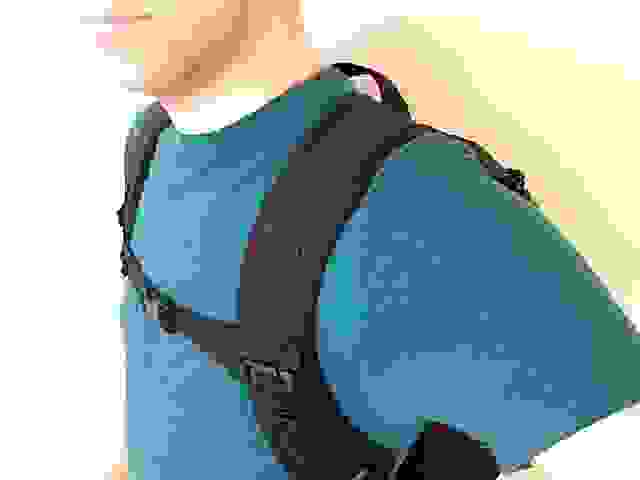
I have absolutely no idea why this is such a rare feature, because it’s just objectively terrible to do it any other way.
And although widening the space between the shoulder straps can eventually become a problem for smaller people, I didn’t have much of a problem with this; I simply make frequent use of the sternum strap. Without it, the straps feel just a bit too far apart. I wear a men’s size small, and I expect that anyone smaller or with sloping shoulders might find the strap placement too wide, but making use of the sternum strap will solve this. Just expect that if you’re tiny, using the sternum strap will feel more comfortable than not using it.
2) Lumbar support
This is also an objectively correct design decision, but one which I have literally never seen before in the entirety of my existence. The backrest actually curves at the lower back, to match the curvature of a human spine. You know, because it’s designed for humans, like all packs should be?
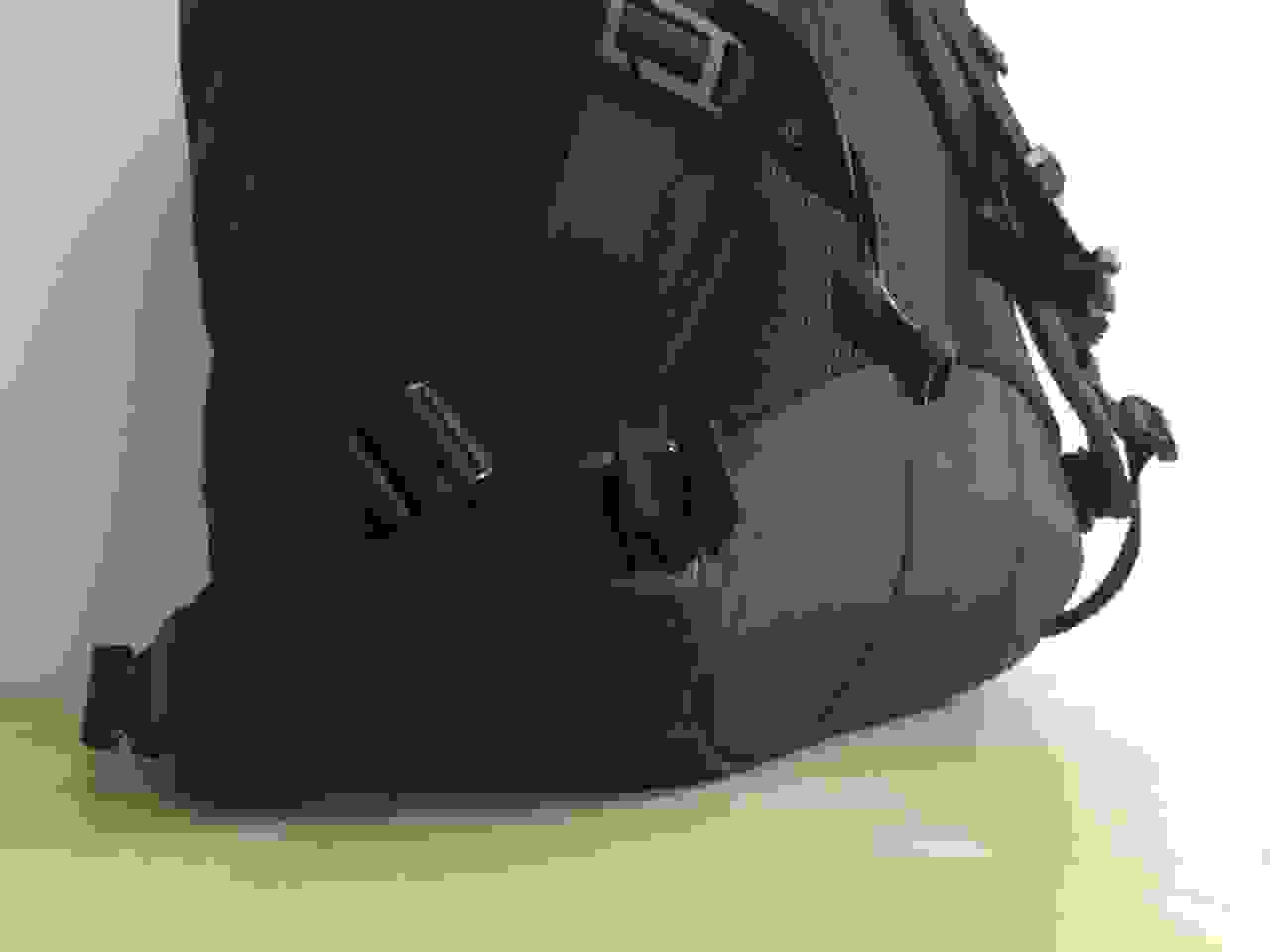
I have no idea why nobody else does this, because it’s just objectively correct. Other companies will often put extra padding on the backrest to make it more comfortable, but you can reduce the amount of padding necessary for comfort by simply shaping the backrest properly to begin with.
Besides, it’s not like gravity is pulling horizontally, so there’s a point at which additional padding would become objectively useless, whereas proper curvature would transfer the weight from the shoulders to the hips, which is exactly what you’d want the pack to do. Obviously a cheap bag with no structure will allow you to pack in such a way that it achieves this curvature as well, but of course a cheap bag with no structure will have its own problems.
As you might expect, you can maximize the curvature by storing big, bulky, soft things in that spot, like a sweater. In the photo above, there’s a packing cube full of clothing in that spot, which is flexible enough to conform to the curvy lumbar shape quite nicely. Textbooks will obviously ruin it, though stuffing a sweater underneath will fix it. I wouldn’t worry too much about it for short trips, though.
The padded laptop sleeve is also suspended high enough that I think you’d need maybe a 15″ laptop for it to interfere significantly with this curve, in which case it will simply be slightly less curved, and still work fine.
And let’s not forget the other distinction that makes this pack vastly more comfortable than others of this type:
3) The water bottle pocket is centered!
As mentioned earlier, this makes a huge difference in comfort, as it distributes the weight more evenly across your shoulders, rather than dragging you down along one side. I find this to be exceptionally helpful, especially if you’re carrying a heavier-than-average water bottle filled up completely. And if not, it’s still useful for compartmentalization anyway.
4) It has plenty of comfy strap options
The Synapse includes a sternum strap and a waist strap, both of which are removable, and leave behind only fabric, rather than buckles, and slip right back on when you want them again.
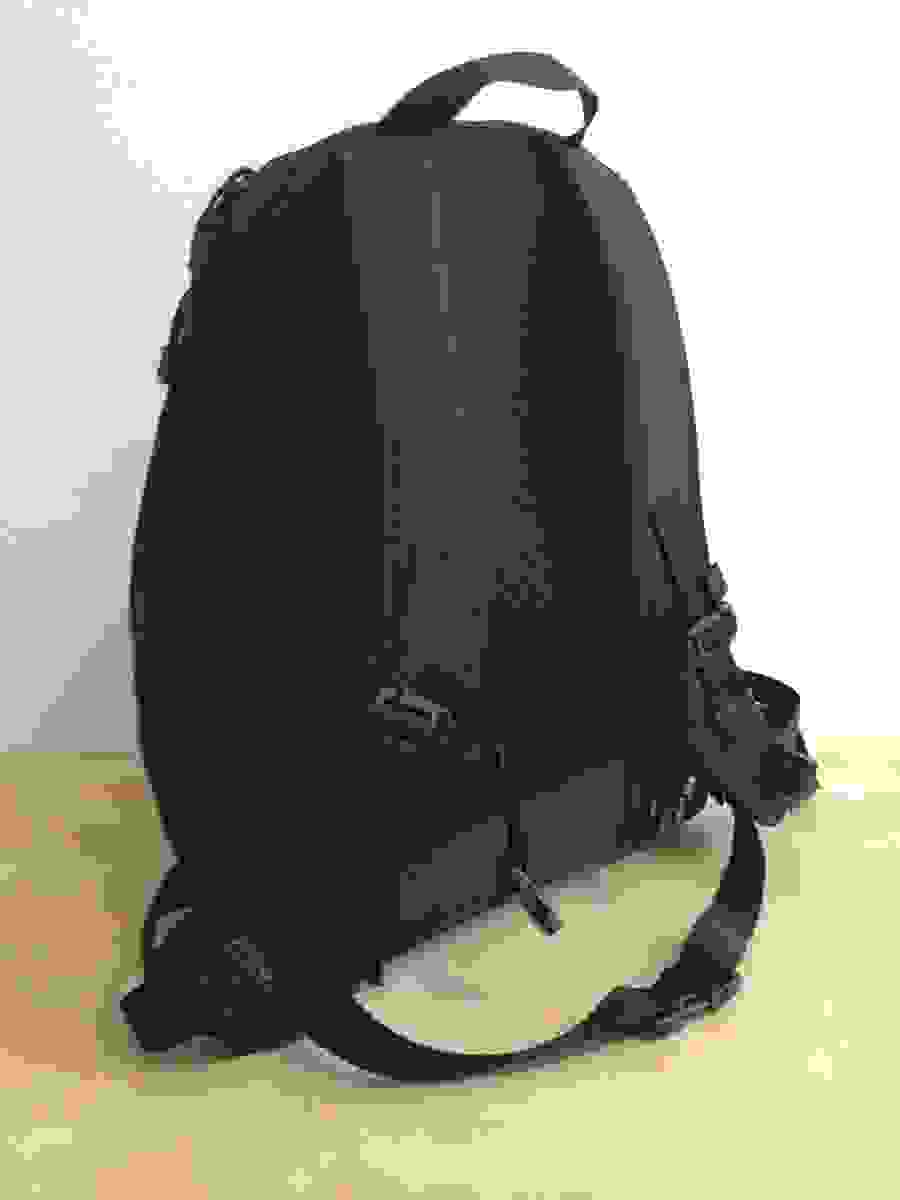
As a scrawny weakling, I make frequent use of both, and I found the waist strap to make a huge difference in comfort, even though it’s just a simple strap. I have no idea how people can possibly live without one. Probably muscles.
On a minor note, the dangly ends of the sternum and waist strap can tuck away into their own attachment points, which worked out quite nicely. Larger people will wear them more loosely, so they might not be able to do this, but then again, the dangly ends will be significantly shorter on larger people, so there’ll be less dangling anyway.
4) A little on breathability
As far as I’m concerned, the only breathable pack is no pack, because I get absurdly overheated no matter what I’m doing. I remember once unclipping a pack on a Bulgarian hilltop and waving my shirt in the wind like a surrender flag in an attempt to dry it out. On a cold day.
From then on I had sworn to use nothing but backpacks with trampoline-style suspended mesh back panels, or messenger bags. These have their own downsides, but at least I wouldn’t look like I had just climbed out of a pool.
That said, the mesh used in the back panel on the Synapse is the good kind, as opposed to spongy mesh that squishes flat and compresses its air channels down to nothing, and it was significantly more breathable than several other packs I’ve used, and far less of a problem than I’d expect from non-trampoline back panels.
But I also found myself getting into the habit of just carrying it over one shoulder for a while to cool off, which would be somewhat awkward on larger packs with padded hip belts. It’s light enough, even when full, that it’s easy to walk like this for a while before going back to normal, and it’s nice to give your shoulders some variety anyway.
So, all in all, I found the Synapse to be far more comfortable than I’d expect from a “normal” pack like this, and better than the last few hiking packs I’ve tried, due to the centralized water bottle compartment, the curvy lower back panel, and non-gougy shoulder straps, and my unease over the non-trampoline back panel and non-padded hip strap worked out just fine. Life is grand.
Any caveats?
Maybe. The layout is so different that it’s worth taking a few things into consideration:
- The water bottle pocket places a heavy object high up in the pack, meaning it can sometimes flop over if you unzip the main compartment all the way. Also, if the lower compartment is empty, the water bottle pocket will squish it when placed on the ground, so be aware of this when setting it down on the ground, so it won’t fall over. Also, since it’s designed to accommodate large or small bottles, a skinny bottle might lean diagonally, rather than stay perfectly upright; this can be fixed by using the side pockets, or just sticking an umbrella inside the central pocket, or just not caring.
- The compartmentalization is incredibly helpful in staying organized, but also means that if you intend to pack it to its full capacity, you’ll need to play Tetris and arrange items according to which pockets they can fit most efficiently into, rather than shoving everything into one giant compartment. I find the organizational advantage to be extremely helpful, but filling it to capacity will take some experimentation.
- It has no external mesh pockets, nor any compression straps, which means there aren’t many options for lashing things to the outside, though the large grab handle and bike light strap help. You can make up for the lack of compression with clever compartmentalization, and remember that it’s bigger than you might expect.
- As mentioned, grabbing the laptop sometimes brings the sleeve right along with it, so you’ll need to get used to holding the sleeve down while pulling up on the laptop.
But all in all, these are caveats, rather than real problems.
Thus:
…this is probably the best laptop daypack for frequent air travel
I’d have a hard time conceiving of something that would pose a challenge to the features of the Synapse, especially for air certain uses. The centrally located and zip-shut water bottle pocket is such a useful feature that I can’t imagine ever doing without it (especially when using filtration bottles, whose extra weight and importance are well accommodated), and its placement defines the rest of the layout, which offers rather unsurpassed organizational efficiency. The shoulder straps and lumbar support offer better comfort than I got from certain packs from reputable outdoor companies, and the travel-friendly laptop sleeve removal is great for flying. Add to that the professional appearance and expert craftsmanship, and you’ve got yourself a great pack.
Though I would expect it to excel in all sorts of situations, I think the Synapse is especially suited to life on the road, where easy access, rain resistance, checkpoint-friendly features, dimensions within carry-on limits, balanced water bottle placement, and an utterly normal appearance become especially helpful. You can even lock the zippers on the main compartment, which has a larger-than-average zipper that can handle a cable lock, without being a “real” locking zipper. I would expect finding a better laptop daypack for frequent travelers would be a cartoonish challenge, except if you just need to carry one gigantic thing at a time, but I much prefer the compartmentalization.
You could easily use a Synapse 25 as your only backpack, particularly on weekend trips and other short excursions (or even indefinite ultralight travel, if you’re really disciplined), though I would expect that for longer trips, most people would prefer to use it as a daypack alongside something else, which would work quite nicely. The non-fussy exterior also has a nice, clean, professional appearance, instead of extraneous straps, snaggy mesh, and fluorescent racing stripes.
Sizing options
As mentioned, this bag comes in 19 or 25 liter versions. I would say that if you’re planning on using the Synapse as just a daypack, intending to carry a laptop (up to 13″), sweater, rain jacket, water bottle, some food, a book, pens and pencils and so on, the 19 liter version will do just fine. If you want something for weekend getaways and road trips, in which case you’d also bring a few changes of clothes, maybe an extra pair of shoes, and some toiletries, you’ll probably want the 25.
Final thoughts!
As you can tell, I’m obviously a big fan. I’ve had my eye on this for a while, particularly due to the Sisyphean ordeal of finding small-to-medium daypacks that can accommodate larger-than-average water bottles without fear of them falling out, and I’m a big fan of the rest of the setup as well. It’s a cleverly designed, immaculately crafted pack, built with solid materials, and with quiet, understated class.
But I also wanted to highlight what makes the Synapse so distinctive. It’s not just good, but uniquely good, and I wanted to go into obsessive detail regarding each and every one of its distinguishing features, particularly for those who only want to buy something once. I think you’d have a hard time finding a new favorite after picking up one of these, despite the innumerable competitors clamoring for your attention.
So if that all sounds good, you can get one right here.
I’m planning on taking this as my one and only pack on an upcoming international trip, after which I’ll return with even more obsessive commentary. Stay tuned.
Update! I recently took this pack on a trip through Central America, and it worked out great. “Where’s your real bag?” is what people would say. As I expected, I enjoyed the easy-to-organize layout and the comfy straps, and it came out with not a single scratch on it. Quite a solid performer throughout, and all it took was hosing off all the dust in the shower to get it ready for its next adventure. Which will hopefully be soon!
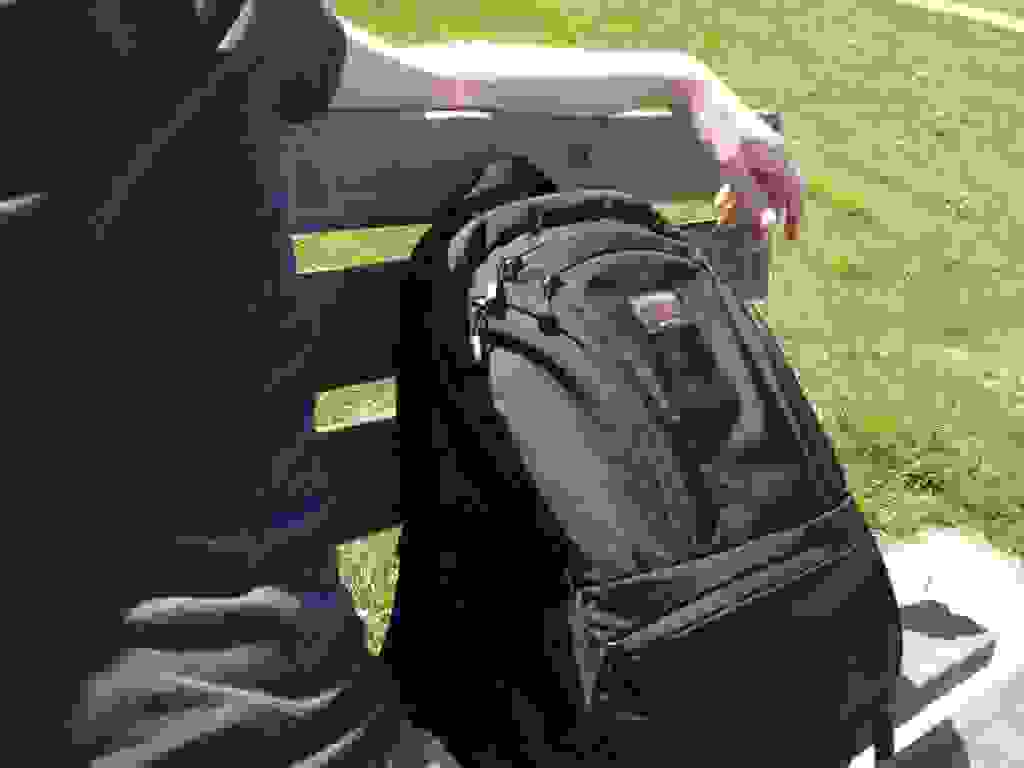
As mentioned, this pack, as well as all accompanying accessories, were provided for free for this review. But, as I’m sure you’ve come to expect by how frequently I complain about even the tiniest of imperfections, all statements here are thoroughly honest opinions.


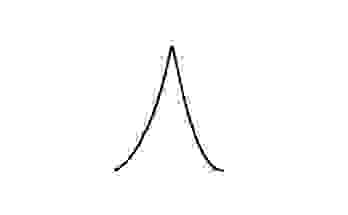

I love the bag, but since its unframed, do you ever have any issues with the back distorting, or with the pack sitting too low? Also, do you think your ultra lightweight winter and regular packing lists would work with the synapse 19?
It helps quite a bit to use a packing cube for the clothes, which gives it quite a bit more structure, and then there’s always a toiletry kit, and a jacket or two that fill up more space, so it’s not flopping around. I don’t think I could make the 19 work for me, but I’ve seen other people online do it. With just 3 changes of clothes, a Kindle or other e-reader instead of books, a smartphone instead of a real camera, and ultralight warm clothing, it’s doable, but I generally need just a bit more warmth in winter, so I usually have one more layer than what I see on those packing lists.
I know you said you used the Tri-Star Medium for the main compartment, but what are all the other TB packs that you used in that bag. I see a bunch of small ones that I cannot seem to place on the site.
Thanks!
The two pouches on the left are called Travel Stuff Sacks (smallest size) and the zippy ones on the right are a 3D Fabric Organizer Cube and a Corder Organizer Pouch (smallest size). I really like the 3D Organizer Cubes. The see-through ones are 3-1-1 sized, for carrying liquids on planes, and they’re a good way to stay organized, and also see what’s inside, and they can be color-coded to help identify them.
Was going to get this one until I saw the price tag. Double the average bag in it’s class!! Do you think it’s worth the price?
One thing that’s worth noting is that it’s made in the USA. Not everyone can afford the extra expense of products like that, but there are plenty of people out there that like supporting locally-made products in conditions that are professional, instead of exploitative. I love getting great deals too, but I’d rather avoid supporting the conditions that make it possible.
But even aside from that, I use it all the time, and I thoroughly enjoy it. There’s nothing else quite like it, with its unique layout and compartmentalized organization, and it hasn’t let me down.
I have had my Synapse 19 for almost 2 years (see my comment above). Yes it’s pricey, but I personally feel it’s worth it. Never regretted the purchase and have only looked for excuses to buy additional accessory pouches, etc.
Has anyone found other pouches that could sub in as replacements (possibly cheaper) for this bag that still attach to the pocket clips? Suggestions welcome.
Sorry to ressurect an old thread, but I was curious to know if you’ve ever compared the Synapse 25 to the 2015 North Face Surge pack? The Surge has similar dimensions to the Synapse 25, and yet shows as being larger (TNF Surge 33 liters / 2014 cubic inches as compared to TB Synapse 25 liters / 1526 cubic liters). Seems odd, and I wonder if it has to do with how they measure them as you mention in your article. Just curious if you’ve compared the two in person?
I’ve tried out some of the North Face packs, and they’re all well made and have plenty of organization, from what I’ve seen. They also have plenty of options, so you can pick something that suits you.
Capacity measurements are always weird. I think one of the issues is that some manufacturers measure how much space the pack takes up, while others measure how much fits inside. Others just use whatever method they feel like, instead of the international standard. Plus they can let it bulge, or not, and so on.
Thanks for the follow up. I love my Synapse 25, but have seen some really good deals on the Surge 2015 version and have been considering picking it up as a “backup” pack for travelling. Based on what I’m seeing however, it may be redundant, as it seems to be almost the exact dimensions, so I probably wouldn’t be able to fit any additional clothing items in it.
i’m curious about your description of the hip belt. you complained about the flimsy hip belt on the minaal 1.0 but this one looks just as flimsy. is it just the overall structure of the pack that makes it workable? i’m trying to get detailed because i have a bad back where the shoulder and neck meet and it’s seriously been a pain trying to find something that ticks all my boxes. travel friendly, carry on friendly, laptop sleeve, good hipbelt, as lightweight as possible. it looks like the minaal 2.0 would work but the price is a bit tough to deal with, especially including the hip belt. any suggestions? thanks!
So it really depends on body type and where the hip belt fits on your body; for me, the Synapse happened to fit right where it wasn’t digging into any hip bones, and even with the pack filled up and the hip belt tightened snugly, it was still fine. But other backpacks or other body types will work differently, and the strap might go over a sensitive area. That’s why a padded hip belt generally works better, because it will fit a wider range of people, and if it goes directly over the hip bone, it’s not the end of the world.
My pick for a budget version of the Minaal is the Gregory Border 35. It’s extremely similar, though with fewer features, but it’s about half the price.
Thanks for the reply. I was about to pull the trigger on a border 35 a month or so ago but then I learned that they updated it and removed the hip belt:/ looks like it used to be a great pack though.
Hmm…that appears to be the case. I think it’s discontinued anyway, which makes me a little sad. Oh well though. There are new options appearing here and there all the time.
What is the material with which this Synapse backpack is constructed–is is Cordura? It doesn’t look like Cordura in you photos. Can you comment on the material, please? Light, heavy, rough weave…? It looks smooth.
Thank you!
They usually use Cordura or a fabric they call Halcyon (which has Dyneema threads), but this particular one was a limited production using what they sometimes call Parapack, but they don’t offer it in that fabric anymore. It’s similar in texture and weight to the Halcyon, though. If you want a fabric feel, get Cordura; if you want a smoother feel, get the Halcyon.
Hi Snarky,
Your blog made be hear about the TB Synapse 25 and I’ve been using it for commutes, travel, even grocery shopping and it’s just great. About cubes.. what packing cube (which size in L) would you use for a long term travel purpose? Just to keep things more organized in the Synapse 25?
Rui
So the packing cubes they offer that fit with the Synapse 25 are the Western Flyer medium (which is fairly thin) and the Aeronaut 30 large, or full size, or whatever it’s called (which is the same size square, but deeper). There might be some other ones, since they custom-make packing cubes to fit certain bags, so they might have others. You can also use their half-size cubes and just stack them vertically inside (using the Aeronaut end pocket cubes, for example).
Hey,
Thanks for posting this review. Can always trust you to have a good, well-reasoned opinion on the things you test. I come here often.
Does the bag have any good spot for storing a lunch? I’m going to be using this for going to campus, and I’m there all day. So having a spot to store a couple Tupperwares would be good.
Thanks!
I think low-profile lunch boxes would fit nicely in that divider panel in the main compartment. Things tend to stay upright in there, especially if there’s a jacket or something like that in the regular part of the main compartment.